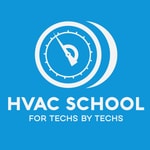HVAC School - For Techs, By Techs – Détails, épisodes et analyse
Détails du podcast
Informations techniques et générales issues du flux RSS du podcast.

HVAC School - For Techs, By Techs
Bryan Orr
Fréquence : 1 épisode/4j. Total Éps: 825

Classements récents
Dernières positions dans les classements Apple Podcasts et Spotify.
Apple Podcasts
🇨🇦 Canada - careers
28/07/2025#29🇺🇸 États-Unis - careers
28/07/2025#31🇨🇦 Canada - careers
27/07/2025#14🇺🇸 États-Unis - careers
27/07/2025#28🇨🇦 Canada - careers
26/07/2025#11🇺🇸 États-Unis - careers
26/07/2025#25🇨🇦 Canada - careers
25/07/2025#12🇺🇸 États-Unis - careers
25/07/2025#29🇨🇦 Canada - careers
24/07/2025#10🇺🇸 États-Unis - careers
24/07/2025#33
Spotify
Aucun classement récent disponible
Liens partagés entre épisodes et podcasts
Liens présents dans les descriptions d'épisodes et autres podcasts les utilisant également.
See all- https://jamesclear.com/atomic-habits
569 partages
- https://www.trutechtools.com/
564 partages
Qualité et score du flux RSS
Évaluation technique de la qualité et de la structure du flux RSS.
See allScore global : 48%
Historique des publications
Répartition mensuelle des publications d'épisodes au fil des années.
Q&A - Condensating Vents - Short #208
mardi 3 septembre 2024 • Durée 13:06
In this short Q&A podcast episode, Bryan answers Kenton's question about how to stop vents from condensating, especially when sealing and insulation don't do the trick.
When approaching a condensation problem, we have to consider the source of moisture and where the condensation is happening. Moisture that builds up on top of the vent comes from attics with a high dew point. (It's not because hot meets cold! Relative humidity and dew point are a lot more important, though hot air is able to hold more moisture.) Warm, moist air with a high dew point hits a colder surface when there is improper sealing and insulation where the duct attaches to the boot.
People often attempt to solve condensation issues by adding insulation, which actually has the opposite effect because it reduces the surface temperature; condensation worsens. Some people also increase attic ventilation, but that may cause pressure imbalances that drive moist air into the conditioned space.
The best way to control attic conditions is to seal and then dehumidify the attic, though it is an expensive and time-consuming measure. Exhaust vents that end in the attic also add moisture to the attic. Sealing vents and other areas where attic air can seep into the space is another best practice, as is deploying a humidity control strategy. Reducing humidity can happen with a dehumidifier and proper sizing so that the HVAC equipment has long runtimes with a cold evaporator coil (achieved with lower system airflow).
Have a question that you want us to answer on the podcast? Submit your questions at https://www.speakpipe.com/hvacschool.
Purchase your tickets or learn more about the 6th Annual HVACR Training Symposium at https://hvacrschool.com/symposium.
Subscribe to our podcast on your iPhone or Android.
Subscribe to our YouTube channel.
Check out our handy calculators here or on the HVAC School Mobile App for Apple and Android.
Residential & Rack Startup and Commissioning (Part 2)
jeudi 29 août 2024 • Durée 39:16
In this episode, Bryan and Max discuss commercial supermarket startup and commissioning with comparisons to residential HVAC work. Max, who has transitioned from residential air conditioning to supermarket refrigeration, shares his insights on the unique challenges and requirements of this specialized field.
The conversation begins by emphasizing the critical importance of safety in supermarket refrigeration work. Unlike residential jobs, technicians often work alone in potentially hazardous environments with high-voltage equipment and large quantities of refrigerant. Hearing protection is stressed as a crucial safety measure due to the extremely loud environments in motor rooms.
Max then delves into the complexities of supermarket refrigeration systems, describing the various components involved, including parallel compressor racks, refrigerated cases, and multiple control systems. He highlights the need for adaptability and problem-solving skills, as technicians often encounter unique situations with limited documentation or manufacturer support. The discussion also covers the time-sensitive nature of the work, with many tasks needing to be completed overnight to minimize disruption to store operations.
The podcast explores the multifaceted role of a supermarket refrigeration technician, touching on topics such as equipment decommissioning, pressure testing, electrical verification, and programming of control systems. Max emphasizes the importance of developing a comprehensive process and continuously refining it to improve efficiency and effectiveness in the field.
Key topics covered in the podcast:
- Safety considerations in supermarket refrigeration work
- Components of commercial refrigeration systems (compressor racks, cases, controls)
- Time constraints and overnight work in supermarket settings
- Decommissioning old equipment and installing new systems
- Pressure testing and leak checking procedures
- Electrical verification and three-phase power considerations
- Programming and verifying control systems
- Defrost cycle setup and verification
- Communication protocols and building management systems
- Performance audits and client expectations
- Low ambient controls and regional differences in system requirements
- Leak detection and walk-in cooler maintenance
- The importance of developing and refining work processes
- Transition from residential HVAC to commercial refrigeration
Have a question that you want us to answer on the podcast? Submit your questions at https://www.speakpipe.com/hvacschool.
Purchase your tickets or learn more about the 6th Annual HVACR Training Symposium at https://hvacrschool.com/symposium.
Subscribe to our podcast on your iPhone or Android.
Subscribe to our YouTube channel.
Check out our handy calculators here or on the HVAC School Mobile App for Apple and Android.
STOP Overthinking! - QA Short #204
mardi 30 juillet 2024 • Durée 09:05
In this short podcast from our Q&A series, Bryan answers a viewer question and implores you to STOP overthinking in the trade! He also shares a parable and some tips to help stop overthinking, especially if you're just starting out in the trade.
In many cases, the simplest assumption is the right one (this is called Occam's Razor). We can always start with the most obvious or simplest possible answer. We can become mindful of our tools, such as by making sure our seals are intact, and we become masters of the obvious.
Perfecting little things (and micro-tasks) can help you become more familiar with the tools you use and the equipment you work on, and you start to develop a bigger-picture understanding of your craft. Cleaning the equipment and organizing your tool bag goes a long way; you can unlock the ability to zoom out and spot mistakes that you otherwise wouldn't have thought of otherwise.
Have a question that you want us to answer on the podcast? Submit your questions at https://www.speakpipe.com/hvacschool.
Purchase your tickets or learn more about the 6th Annual HVACR Training Symposium at https://hvacrschool.com/symposium.
Subscribe to our podcast on your iPhone or Android.
Subscribe to our YouTube channel.
Check out our handy calculators here or on the HVAC School Mobile App for Apple and Android.
Filter Driers and System Cleanup w/ Copeland
jeudi 27 juillet 2023 • Durée 54:41
Jim Fultz and Jim Hagl from Copeland join the podcast to talk about filter driers and system cleanup. Filter driers come in many types and sizes; they typically go on the liquid line (bi-flow filter driers are used on heat pumps), but suction line filter driers also exist.
Copeland’s liquid line filter drier models include the EK (premium), BSL (smaller diameter), BOK (with HH desiccant to assist with burnout cleanup), and CU (copper spun). Bi-flow filter driers in Copeland’s lineup include the BFK and BSB categories. These liquid line filter driers protect the metering device and should typically be installed as close to the metering device as possible (with some exceptions for heat pump startups in heating mode). These filter driers typically need to be replaced anytime the system is opened for service, the pressure drop across the drier exceeds 3 PSI, or the system is wet.
Suction line filter driers in Copeland’s lineup include the ASD, SFD, and CSFD models, all of which come in different shapes and sizes for varying applications. The ASK suction line filter drier has activated carbon to assist with burnout cleanup. When used to assist with contamination cleanup, suction line filter driers must be taken out of the system within a few days.
Jim F., Jim H., and Bryan also discuss:
- Copeland and Emerson brand realignment
- Filtration data
- Myths about smaller-diameter filter driers
- Copper-spun drier uses and applications
- Ideal vs. accessible suction filter drier placement
- Desiccant considerations
- Filter drier selection best practices
- Moisture indicators
- Restricted filter driers
- Filter drier sizing and system charge
- Bi-flow driers in straight-cool systems
- Dealing with factory-installed filter driers
- Product names and suffixes
- Burnouts and oil
- Flowing nitrogen while brazing
- Additives and flushes
Check out Copeland’s filter driers at https://hvacrschool.com/copeland-driers.
Learn more about the HVACR Training Symposium or buy a virtual ticket today at https://hvacrschool.com/symposium.
If you have an iPhone, subscribe to the podcast HERE, and if you have an Android phone, subscribe HERE.
Check out our handy calculators HERE.
So... What Do You Do? - Unconformed - Short #170
mardi 25 juillet 2023 • Durée 13:37
In this short episode, Bryan goes over the fourth chapter of his new book, Unconformed. The chapter is called "So... What Do You Do?"
Parents always want to be proud of their children, but it seems as though children are more proud of children who attend college than take up apprenticeships. However, these feelings largely seep in due to peer expectations; we want our children to measure up to our friends' standards or success, not necessarily our own. Parents are also less likely to encourage their children to get into the trades and value the time and expertise of tradespeople.
All jobs, even less prestigious jobs, matter and have a purpose. Society tends to devalue tradespeople and manual laborers, but those jobs do a great service to society. Nevertheless, the competitive drive between parents and our fear of failure makes us fall into these mindsets where we devalue manual labor. The media and family members also trap us in these expectations.
Society runs on the ability of people to solve problems and innovate, which means that blue-collar work is necessary for society to function. Not to mention, popular media and DIY culture have also brought attention to the artistry of the skilled trades. These positive changes are important to the perception of blue-collar work, and we can accept (and encourage) a child's choice to find purpose in the skilled trades, not just blindly seek happiness.
Bryan also covers:
- Networking
- Expectations vs. standards
- The pitfalls of happiness
- The merits of working with our hands
You can purchase Unconformed on Amazon's website HERE.
Learn more about the HVACR Training Symposium or buy a virtual ticket today at https://hvacrschool.com/symposium.
If you have an iPhone, subscribe to the podcast HERE, and if you have an Android phone, subscribe HERE.
Check out our handy calculators HERE.
Pipefitting Best Practices
jeudi 20 juillet 2023 • Durée 01:16:49
This podcast is based on a Kalos meeting about pipefitting best practices, particularly in commercial refrigeration applications. It begins with a few words about quality workmanship by the Kalos founder and CEO, Robert Orr.
Pipefitting consists of repairs and joining metals; when joining metals, we need to liquify the alloy and draw it into the joint via capillary action. When pipefitting, oxygen can present some problems by coating the inside of the pipe with oxides that can contaminate the system. We can reduce the likelihood of oxide formation by flowing nitrogen while brazing; purging nitrogen displaces the oxygen in the lines before brazing, and flowing keeps oxygen out during the brazing process.
Tip selection will be based on the piping diameter; tips that are too small won't adequately heat the pipe, and tips that are too large will consume too much fuel. You'll also need to leak-check your torch tanks and ensure that you have the appropriate ratio of oxygen to acetylene by aiming for a neutral flame rather than a carburizing or oxidizing flame.
After brazing, we need to perform a nitrogen pressure test to ensure that the system is leak-free. Then, once the pressure test is passed, we should evacuate the system to keep the system clean, dry, and tight.
Bryan, Matthew, Roman, and Nathan also cover:
- Brazing vs. soldering
- Properties of base metals
- Alloy properties and appropriate uses
- Mineral oil vs. POE oil and cupric oxide
- Safety practices and PPE
- Preparing copper (sealing, deburring, etc.)
- Valve seating
- Penetration and the gaps between surfaces
- Base metal temperature indications
- Advantages of nitrogen for pressure testing
- Vacuum pump best practices
- Micron gauges
Learn more about the HVACR Training Symposium or buy a virtual ticket today at https://hvacrschool.com/symposium.
If you have an iPhone, subscribe to the podcast HERE, and if you have an Android phone, subscribe HERE.
Check out our handy calculators HERE.
Filter Driers and System Protection - Short #169
mardi 18 juillet 2023 • Durée 17:27
In this short episode, Bryan talks about filter driers and their important role in HVAC/R system protection, especially in accordance with Copeland's (formerly Emerson's) AE24-1105 R5.
We can really start keeping our systems contaminant-free by handling tubing properly, purging and flowing nitrogen, and keeping copper shavings out of the tubing when deburring or reaming. Suction and liquid filter driers protect the system during operation and are designed for specific purposes.
We typically don't install suction filter driers in residential systems unless we're fixing a system with compressor burnout or acid contamination; in those cases, we also want to make sure we replace accumulators and clean out the line set as well as we possibly can. Commercial refrigeration tends to have more rigorous contamination prevention protocols, including testing oil for acid and installing suction filter driers in everyday operation, due to the use of multiple compressors in a single system.
However, suction driers are recommended in ALL applications per AE24-1105. In many cases, we don't install them in systems because they can create a significant pressure drop in the suction line and damage the compressor, but suction filter driers can provide a net positive effect if we monitor them. We should install suction filter driers as close to the compressor(s) as possible, and we should cut them out when we need to remove them, not unsweat them.
Bryan also covers:
- Liquid line filter drier placement
- Pressure drop across filter driers and replacement thresholds
- Burnout cleanup procedures
- Filter drier sizing
- Refrigerant additives
- Motor burnout in hermetic refrigerant-cooled compressors
- Electrical best practices
For more information about filter drier selection by model number, visit https://hvacrschool.com/copeland-driers.
Learn more about the HVACR Training Symposium or buy a virtual ticket today at https://hvacrschool.com/symposium.
If you have an iPhone, subscribe to the podcast HERE, and if you have an Android phone, subscribe HERE.
Check out our handy calculators HERE.
Alex Meaney - HVAC Design Backwards, Forwards, and In Between
jeudi 13 juillet 2023 • Durée 01:15:59
This podcast episode is one of Alex Meaney's HVACR Training Symposium presentations: HVAC Design Backwards, Forwards, and In Between.
Load calculation factors in all three means of heat transfer: conduction, convection, and radiation. It doesn't directly tell you the tonnage; it just tells you how many BTUs (sensible and latent) are entering or leaving a structure. When designing systems after doing load calculations, we need to be mindful of industry standards and their pitfalls, as well as the climate conditions and the difficulty of obtaining manufacturer data.
Equipment selection by tonnage is only part of the picture when it comes to HVAC design; we also need to factor in airflow and duct design, especially duct sizing. However, many rules of thumb and poorly explained terms are counterproductive to a thorough understanding of HVAC design. In some cases, the best way to design a system may seem "backward," especially when starting with blower selection instead of ductwork.
Duct design is particularly difficult, especially when software identifies several problems with designs that seemed to look good on paper. However, the software points out areas where you can adjust the duct size and manage restrictions to allow the fan to do its job without being derated by friction.
Alex also covers:
- Insulation and efficiency ratings
- CLTD Groups
- Tricky radiant gains and losses
- The relationship between BTUs and tons
- AHRI ratings
- Shortcomings of Ductulators in duct design education
- Pressure vs. friction in ductwork
- Static pressure vs. velocity pressure
- Measuring friction with pressure
- Regulations vs. reality
- Furnace static pressure range
- Differences between commercial and residential duct design
- Oversized and under-ducted systems
- Variable-capacity systems
- ACCA manuals and tables
Check out Alex Meaney's consultation business at https://www.meanhvac.com/.
Learn more about the HVACR Training Symposium or buy a virtual ticket today at https://hvacrschool.com/symposium.
If you have an iPhone, subscribe to the podcast HERE, and if you have an Android phone, subscribe HERE.
Check out our handy calculators HERE.
Santa Fe Panel with Andy Ask and Ken Gehring
jeudi 6 juillet 2023 • Durée 01:16:23
This podcast is the Santa Fe Panel from the 4th Annual HVACR Training Symposium. The panel focused on dehumidification, was moderated by Nikki Krueger, and featured Andy Ask and Ken Gehring.
"Matchmaking" a residence to the climate requires us to design and install equipment that keeps occupants healthy and comfortable. HVAC contractors need to focus on the dew points, especially as they remain high at night and in the shoulder seasons. Humidity loads tend to hold steady (even peak dew points), while sensible loads increase and drop, making it difficult to control latent heat loads the same way we control sensible loads.
The equipment will typically be less efficient if you focus on long runtimes to remove latent heat under partial load conditions and maintain 50% humidity. Dehumidifier efficiency is determined on a pint per kilowatt basis, but a constantly running dehumidifier will do its job a lot more efficiently than one that starts and stops regularly.
The dehumidifier adds heat to the house and should only come on when the HVAC system is having trouble maintaining the desired humidity load; the dehumidifier has a reheat effect, but the HVAC system will need to deal with the increased heat load. When you add a whole-house dehumidifier, adding a fresh air ventilation component is highly recommended.
Nikki, Ken, and Andy also cover:
- Infiltration and exfiltration
- Variable-speed technology and supplemental dehumidification
- Fresh air ventilation
- Air conditioner vs. dehumidifier latent heat removal
- Net zero HVAC, electrification, and decarbonization initiatives
- Air mixing in the ductwork
- Standalone dehumidifiers
- Vapor pressure and buoyancy
- Sizing for peak dehumidification loads
- Dehumidifier supply and return tie-ins
- Static pressure and "injection" dehumidification
- Fan cycling
Learn more about the HVACR Training Symposium or buy a virtual ticket today at https://hvacrschool.com/symposium.
If you have an iPhone, subscribe to the podcast HERE, and if you have an Android phone, subscribe HERE.
Check out our handy calculators HERE.
Where to Place the Micron Gauge - Short #168
mardi 4 juillet 2023 • Durée 10:38
In this short podcast, Bryan talks about where to place the micron gauge during evacuation and how to think about micron gauge positioning.
Evacuation (deep vacuum) doesn't remove solid contaminants, and vaporizing liquid water is a time-consuming process; its main purpose is to remove water vapor, air, and nitrogen gases from the HVAC/R system. When you pull down below 500 microns and hold that pressure, we can make sure we have a clean, dry, and tight (leak-free) system. As we started using R-410A and POE oil, water in the system became a much bigger issue than it was with mineral oil (it was never to have water in the system, but it breaks down POE oil).
Before we start pulling a vacuum on the system, we need to attach our micron gauge to the pump while it's isolated to make sure the pump is working. A modern vacuum pump should pull down below 100 microns in 30-60 seconds; if your pump can't pull down to 100 microns in under a minute when isolated, then you'll want to change the oil (possibly multiple times). Be sure to change the oil regularly and store it properly.
When you pull a vacuum on a system, you'll want to attach your micron gauge as far away from the pump as possible to get an accurate indicator of your vacuum. Use core remover tools to isolate the system and make sure the far side of the system is brought below 500 microns during evacuation. The time it takes to pull down a system and the time you'll hold the vacuum will depend on your application (residential vs. commercial).
Check out Review of Vacuum for Service Engineers (revised by Jim Bergmann and Bryan Orr, 2020) at https://www.trutechtools.com/accutools-review-of-vacuum-for-service-engineers.html.
Learn more about the HVACR Training Symposium or buy a virtual ticket today at https://hvacrschool.com/symposium.
If you have an iPhone, subscribe to the podcast HERE, and if you have an Android phone, subscribe HERE.
Check out our handy calculators HERE.









